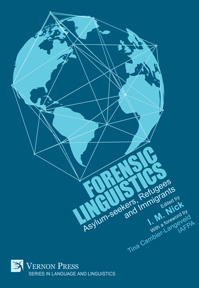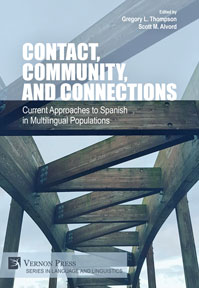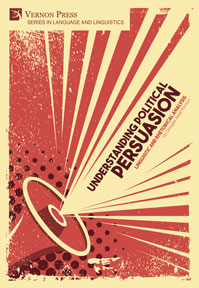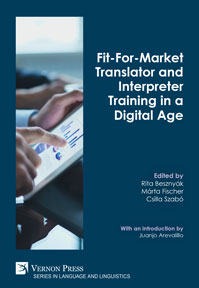Watching in Tongues: Multilingualism on American Television in the 21st Century
by James G. Mitchell (Salve Regina University, USA)
Purchase this book
(click here to change currency)
James Mitchell's 'Watching in Tongues: Multilingualism on American Television in the 21st Century', is an original and innovative study that offers a valuable research contribution. It analyzes second language speakers and second language use on television, which is a promising research area, and it will help spark further work in the area. Arguing for the usefulness of studying applied linguistics on television, Mitchell deploys textual analysis to explicate how the television programs sometimes critique and sometimes reinforce stereotypes about second-language speakers, depending on the context. The book engages a multidisciplinary audience and would interest scholars and students in applied linguistics, such as second language acquisition and sociolinguistics, as well as in television studies, media studies, popular culture studies, and intercultural communication. Watching in Tongues is accessible and engaging and would be a useful textbook for an introductory linguistics course.
Leigh H. Edwards
Professor, Department of English
Florida State University
In “Watching in Tongues”, James Mitchell always offers thoughtful and sometimes provocative analyses of how ESL and second-language learning are portrayed in dozens of popular U.S. television shows, from “Law & Order” and “Lost to The Big Bang Theory” and “Modern Family”. His considerations of how characters speak their languages (both native and L2), the attitudes conveyed by other characters about these languages and the speakers who use them, and what these shows reveal about the place of language learning in American culture provide readers with insights both well-grounded in interdisciplinary scholarly research and accessible to a diverse audience: language-learning specialists, language professionals in a variety of other areas, researchers in popular-culture areas like television and entertainment studies, and even well-read members of the general public.
Mitchell is an engaging writer, using amusing examples and his own humorous take on topics to reinforce his substantive and serious observations and conclusions about language issues portrayed in popular TV shows. Chapter titles like “I Will Not Sugar-Jacket How Much of a Cheapsteak You Are! Second Language Use at the Crossroads of Humor and Social Commentary” and “How I Met Your Foreign Boyfriend: What Primetime TV Tells Us About Popular Attitudes Toward L2 English Speakers” nicely illustrate the mix of pop-culture appeal and linguistic concerns presented in this book.
While the material is thus engaging to both language-lovers and TV watchers, Mitchell often draws pointed conclusions about specific interactions portrayed in his quoted excerpts. To take just one example, in Chapter One, he labels one dialogue in which the writers appear to be making fun of a non-fluent English speaker “mean-spirited” and accuses them of “pick[ing] the lowest hanging fruit on the humor branch,” concluding that “[t]his example demonstrates one of the dangers of employing ethnic humor using L2 English or non-English-speaking characters” (p. 26).
Each chapter is clearly structured to facilitate readers’ comprehension and evaluation. In most cases, after an introductory section setting the stage, Mitchell reviews the relevant background literature, either separately or integrated into the next section; presents data in the form of quotes from various TV shows, with plot summaries and other background as needed and often incorporating helpful analysis; discusses the broader implications of the data and specific analyses covered in the previous section; and concludes the chapter by wrapping up its key findings. The introductory and concluding chapters, of course, serve to set up Mitchell’s focus, goals and approach to the studies included in the book and emphasize the major take-aways from his research, respectively.
My own take-away from reading Mitchell’s book: researchers and others interested in the intersection of language learning, attitudes toward native and non-native language use and its portrayal, and television’s representation of language-related social phenomena will find much food for thought, as well as considerable enjoyment, in this volume.
Dr Deborah Schaffer
Professor of English
Montana State University Billings
This book explores ideas and issues related to second language (L2) speakers and L2 use as portrayed on American television. It examines many examples of television depictions of L2 speakers and L2 use collected in the first decades of the 21st century. The book is divided into four three-chapter sections.
“Humor and Homicide” looks at two aspects of the inclusion of L2 speakers and L2 use on television: L2 use or speakers depicted to create humor in various ways, especially through miscommunication or misunderstanding, and L2 knowledge used to solve crimes in the detective/police procedural genre. The section describes the reasons behind these phenomena, how they work, and the messages they convey to viewers. “Language Learning” explores how both adult and child language acquisition is represented and misrepresented on American television, with analysis of realistic vs. non-realistic depictions. “Subtitles and Stereotypes” explores the ways in which L2 speakers are often negatively depicted on television, their portrayal based on stereotypes. This work specifically investigates the role that subtitles play in leading viewers to such conclusions, employing the idea of language subordination, a process that devalues non-standard language while validating the norms and beliefs of the dominant group. Also considered are ways in which stereotypes are sometimes used to undermine negative perspectives on L2 speakers. “Language Attitudes and Mediation” evaluates depictions of second languages used as tools of mediation in both historical and satirical terms as well as the feelings these portrayals engender in viewers.
In short, this work asks questions that have not previously been posed about L2 use on television, and it provides answers that not only shed light on issues of the representation of language learning and language use, but also constitute a lens through which American society as a whole might be understood.
List of Tables
Acknowledgments
Introduction
Preface by Prof Monika Bednarek
Part I: Humor & Homicide
Chapter 1 I Will Not Sugar-Jacket How Much of a Cheapsteak You Are! Second Language Use at the Crossroads of Humor and Social Commentary
Chapter 2 Psych! You Thought This Show Was in English!
Chapter 3 Second-language Sleuths Solve Mysteries: Decoding Foreign Language Use in Popular Crime and Detective Television
Part II: Language Learning
Chapter 4 Xiaolin Monks Master Metaphor: Acquisition of Second Language Idioms in Children's Television
Chapter 5 Ugly French: Learning a Second Language as an Adult
Chapter 6 Let’s Learn A New Language, America! Fact and Fiction in Representations of Language Learning on TV
Part III: Subtitles & Stereotypes
Chapter 7 Tu Vuo’ Fa’ L’Americano: Italian Use on Primetime TV in America
Chapter 8 How I Met Your Foreign Boyfriend: What Primetime TV Tells Us About Popular Attitudes Toward L2 English Speakers
Chapter 9 Subtitling Language Subordination: Linguistic and Ethnic Stereotyping on TV
Part IV: Language Attitudes & Mediation
Chapter 10 From SNL to Nashville: Attitudes Toward Learning Spanish in American Pop Culture
Chapter 11 Repeating History: Immigrant and First-Gen Children Mediate America on TV
Chapter 12 Mockery and Moxie: Resisting Condescension toward Non-Standard Dialects of English on TV
Conclusion
Appendix
References
Index
James G. Mitchell, Ph.D. graduated from Goucher College (Towson, MD) in 1996 with degrees in biochemistry and French. He went on to earn his Ph.D. in Romance Studies with a specialization in Second Language Acquisition from Cornell University (Ithaca, NY) in 2001. Since 2001, he has been employed as a professor at a variety of institutions from large state universities to small liberal arts colleges. Since 2006, he has been at Salve Regina University (Newport RI) where he is currently Professor of French, Italian, and Linguistics. His overarching research specialization is second language acquisition, specifically aspects of classroom acquisition and second language pedagogy.
See also
Bibliographic Information
Book Title
Watching in Tongues: Multilingualism on American Television in the 21st Century
ISBN
978-1-64889-072-7
Edition
1st
Number of pages
250
Physical size
236mm x 160mm

![Watching in Tongues: Multilingualism on American Television in the 21st Century [Paperback]](/file/12343/8a658a8987af9aba29f9bf73fed17970/1594307241.jpg)







